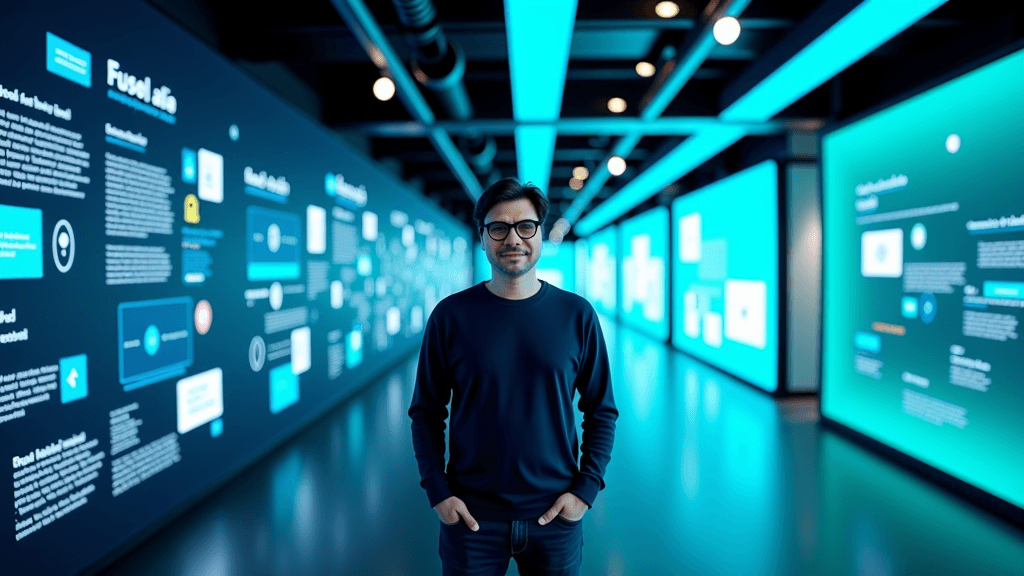When AI News ‘Stops’: Why Quiet Days Reveal More About Technological Maturity Than Big Announcements
October 24, 2025 | by Matos AI

Something interesting has happened in the last 24 hours: practically no relevant news about artificial intelligence has emerged from the Brazilian or global scene. In a world where we follow trillion-dollar investments on a daily basis, announcements of revolutionary products and warnings about speculative bubbles, a ‘silent’ day may seem strange.
But should we be worried? Or does this moment of apparent calm actually reveal something much deeper about where we are on the AI journey?
The Paradox of Silence in the Midst of a Hurricane
In recent months, we've seen a constant avalanche of developments: Brazilian teachers leading the world in AI adoption with 56% of use, investments of R$ 3.4 billion in the country, and 63% of the population already experimenting with some form of artificial intelligence. We live in a frenetic pace of news, where every day brings a new billion-dollar startup, a more powerful model, or a warning about disruptive transformations.
Join my WhatsApp groups! Daily updates with the most relevant news in the AI world and a vibrant community!
- AI for Business: focused on business and strategy.
- AI Builders: with a more technical and hands-on approach.
In my work with companies and executives, I realize that the constant speed of news has created a kind of ‘information anxiety’. Leaders feel pressured to react to every movement, as if not implementing something new for a day is synonymous with falling behind.
But here's the thing: technological maturity is not measured by the amount of daily news, but by consistency in implementation and the creation of real value.
What Silence Reveals About Maturity
When a technology really matures, it stops being a novelty and becomes an infrastructure. Think of the internet: when was the last time you saw a headline like “Companies Massively Adopt the Internet”? We don't see it anymore because it's already integrated into the fabric of our society.
This moment of relative quiet in AI news may indicate just that: AI's transition from technological curiosity to essential work tool.
Signs of Maturity I Observe
In my consultancies and mentoring, I have noticed significant changes in the way companies and professionals approach AI:
- Less experimentation, more implementation: Companies have stopped doing ‘pilot projects’ and started integrating AI into real processes
- Focus on ROI, not headlines: The conversation has shifted from “what technology to use” to “how much value does it generate”
- Standardization of use: Professionals use AI as they would any other work tool
- Proactive regulation: Governments and organizations create frameworks before problems become crises
Brazil: From Experimentation to Implementation
The Brazilian scenario is particularly interesting in this context. When we look at recent data - teachers leading the world in adoption, billionaire investments in public AI, and high penetration among the population - we see a country that is not chasing the hype, but building real capabilities.
In conversations with leaders from different sectors, I realize that Brazil is experiencing a unique moment of ‘conscious adoption’ of AI. We are not simply importing ready-made solutions; we are developing our own approach, which combines technological innovation with local needs.
SERPRO and Digital Sovereignty
A clear example of this maturity is SERPRO's development of its own AI models. While other countries rely entirely on foreign solutions, Brazil invests in in-house capabilities. This doesn't generate spectacular daily headlines, but it does build solid foundations for the future.
Education: The real thermometer
The fact that 56% of Brazilian teachers already use AI is far more significant than any corporate announcement. Education is traditionally one of the most conservative sectors in terms of technological adoption. When we see this penetration, it indicates that the technology has reached a level of maturity and usability that allows it to be integrated naturally into day-to-day work.
Why Quiet Days are Strategic
Paradoxically, the days without big news are the most important for building sustainable competitive advantages. That's when we stop reacting to the market and start thinking strategically about how to use technology to create real value.
The Reactivity Trap
I see many companies falling into the trap of reactivity: every week they implement a new AI tool because they've seen an exciting piece of news. The result? Several one-off solutions that don't talk to each other, confused teams, and little real impact on results.
True transformation happens when we stop chasing novelties and start focusing on results.
The Power of Consistent Implementation
In my consulting projects, the companies that generate the most value with AI are those that:
- They choose 2-3 specific use cases and execute them perfectly
- Invest in continuous team training
- Create clear governance and ethics processes
- Measure results accurately
- Scale up gradually based on learnings
None of these practices generate headlines, but they all generate real results.
The Current Moment: Strategic Opportunity
This moment of relative quiet in the news represents a unique opportunity for companies and professionals to position themselves strategically. While the market is not being bombarded with daily news, it is the ideal time to:
1. Consolidating lessons learned
Over the last couple of years, we've tried out a flurry of tools and approaches. Now it's time to evaluate what really works in your specific context. Which implementations generated value? Which were just expensive experiments?
2. Invest in Deep Training
Instead of chasing the next tool, invest in a deep understanding of how AI can transform your core processes. Competitive advantage doesn't come from using the newest tool, but from using any tool better than the competition.
3. Develop Robust Governance
Moments of calm are ideal for building governance, ethics and compliance frameworks. It is much easier to implement good practices when there is no pressure to launch something ‘yesterday’.
4. Focus on the Customer Experience
With fewer technological distractions, we can focus on what really matters: how AI improves the experience of our customers and end users.
Lessons from the Brazilian Journey
The Brazilian experience offers valuable lessons on how to navigate times of technological transition:
Organic Adoption vs. Top-Down Imposition
The fact that Brazilian teachers lead the world in adopting AI was not the result of a government directive, but of an organic adoption motivated by real needs. This suggests that AI has really reached a level of maturity and usefulness that allows spontaneous adoption.
Investment in Infrastructure vs. Marketing
While we see global companies spending billions on marketing and spectacular ads, Brazil has consistently invested in infrastructure and training. The R$ 3.4 billion in public investment in AI represents a bet on building long-term capabilities.
Inclusion vs. Elitization
With 63% of the population having already experienced AI, Brazil demonstrates that it is possible to democratize access to technology. This contrasts with scenarios where AI remains restricted to a technical or economic elite.
What to Expect from the Next Moves
Based on the patterns I observe in the market and my experience supporting companies in digital transformation, I believe that the next developments in AI will be characterized by:
Less Spectacle, More Substance
I expect to see fewer grandiose announcements and more solid implementations. The “AI washing” phase is coming to an end, and the market will begin to demand concrete results.
Focus on Integration
Instead of isolated tools, we will see solutions that integrate natively into existing workflows. AI will no longer be an ‘add-on’ but an intrinsic part of processes.
Regional customization
Countries like Brazil, which have invested in their own capacities, will begin to see the fruits of this strategy in the form of solutions that are more suited to local realities.
Preventive Regulation
Mature regulatory frameworks will emerge, allowing responsible innovation without the extremes of a total absence of rules or excessive regulation.
How to Seize the Moment
For companies and professionals who want to position themselves strategically at this time of transition, I recommend it:
1. Audit Your Current Implementation
Make an honest assessment of how you have used AI so far. What concrete results have been achieved? Where have resources been wasted? What lessons can be applied to future implementations?
2. Invest in Internal Skills
Instead of relying entirely on external suppliers, develop internal capabilities for understanding and managing AI. This doesn't mean that everyone needs to become a programmer, but that your team needs to understand how to evaluate, implement and optimize AI solutions.
3. Define Your Data Strategy
AI without quality data is like a race car without fuel. Use this time to organize, clean and structure your data so that it can feed future implementations efficiently.
4. Build Strategic Relationships
Identify partners, suppliers and specialists who can support your long-term journey. Relationships built in moments of calm are more solid than those formed in the rush to resolve a crisis.
The Importance of the Long-Term Perspective
One of the most important lessons I've learned in more than 25 years of supporting startups and companies in digital transformation is that sustainable competitive advantages are built in moments of apparent calm, not during hurricanes of hype.
When everyone is chasing the latest thing, there is little room for strategic reflection and careful implementation. It's in the intervals between waves that we can position our board to catch the next one more efficiently.
The Example of Great Transformations
Think of the great technological transformations in history: the internet, smartphones, cloud computing. In all cases, the companies that have benefited most have not necessarily been the first to make a fuss, but those that have been able to implement technology consistently and strategically.
Amazon wasn't the first online store, but it has consistently built up e-commerce and logistics capabilities. The iPhone wasn't the first smartphone, but Apple has spent years perfecting the user experience. Microsoft didn't create cloud computing, but it has built Azure methodically and strategically.
Final Reflections: The Value of Time
In a world obsessed with speed and disruption, it's easy to forget that some of the most important transformations happen silently. AI is becoming part of the fabric of our society not through spectacular announcements, but through consistent and useful implementations.
Brazil, with its 63% of population adoption and global educational leadership, is demonstrating that it is possible to be a protagonist in the AI era without falling into the traps of hype and reactivity.
This moment of relative quiet in the news is actually a gift. It's an opportunity to breathe, evaluate, plan and implement with intentionality. It's when we build the foundations that will allow us to ride the next waves with more skill and less anxiety.
The question is not “what are we going to do with the next big thing in AI?”, but “how are we going to use what we already have more intelligently?”
In my mentoring and consulting work, I have the privilege of helping executives and companies navigate exactly this transition - from a reactive approach to a proactive and sustainable AI implementation strategy. Because, at the end of the day, it's not the technology that transforms businesses, but how we use it to create real value for real people.
And that, fortunately, doesn't depend on daily headlines.
✨Did you like it? You can sign up to receive 10K Digital's newsletters in your email, curated by me, with the best content about AI and business.
➡️ Join the 10K Community here
RELATED POSTS
View all



